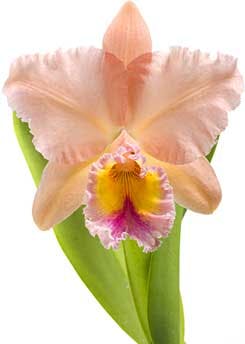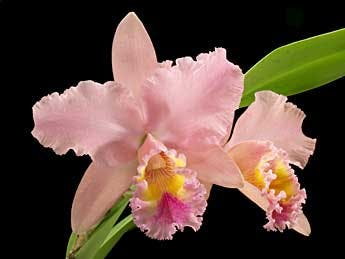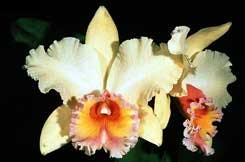Rhyncholaeliocattleya George King 'Serendipity' AM/AOS

Some orchids become classics that are always available and always in demand. Guaritonia (Cattleytonia) Why Not, Phalaenopsis Baldan's Kaleidoscope and Paphiopedilum Maudiae come to mind as examples. It may be ease of growth, awesome beauty of the flowers, or just the serendipity of marketing that has catapulted such orchids to fame and popularity making them part of orchid collections far and wide. In conversation at shows and meetings, these orchids are often referred to by just the grex name, like old friends. One of my personal favorite "classics" is Rhyncholaeliocattleya George King 'Serendipity' AM/AOS. It is a cross between Rhyncholaeliocattleya Buttercup x Cattleya Bob Betts, and was registered by G.A. King in 1970. This hybrid embodies all of the fine qualities one would expect in a standard Cattleya hybrid. Two or three large, flat flowers are produced and well-held on a strong inflorescence. The flowers are usually spaced nicely and rarely crowded. They open a soft pink and over the first few days, progress toward a salmon-peach color that is hard to actually describe, but is instantly recognizeable on a nursery bench or show table. As they age they tend toward apricot-peach with more of an orange overtone. For me, this transformation greatly adds to my enjoyment of this orchid because I get to enjoy its many nuances. One of Rlc.(Blc.) George King's extra bonuses is the delicious fragrance that can perfume a whole room. Although the Rhyncholaelia digbyana parent is four generations back, the sweet citrus fragrance is unmistakeable. And if these qualities were not enough to put this grex in the orchid hall of fame, it blooms several times a year for your enjoyment.

Flowers open decidely pink
Let's take a brief look at the breeding line of this remarkable orchid. The pollen parent, C. Bob Betts, is a fifth generation hybrid involving only three species: C. mossiae, C. gaskelliana and C. trianae. Although C. Bob Betts has produced a number of notable hybrids, it appears that most of the efforts were aimed toward white progeny. Any colored offspring produced appears to be a result of the totally unexpected, or the whimsy of hobby breeders who used C. Bob Betts because of its form, size and substance. So the beautiful color of this hybrid must come from the Rlc. Buttercup parent, which is Rlc. Primate x Rlc. Golden Myth. The two most recent award descriptions for Rlc. Buttercup both suggest pink overtones or reddish suffusion of floral parts. This would certainly be expected when we look at its geneology of a dozen or so species, which includes highly colored ones such as Cattleya cinnabarina and C. harpophylla as well as C. bicolor and of course, C. dowiana (25%). What is interesting about Rlc. George King is that I have never seen it produce crippled flowers, that is, deformed flowers with extra tissue on the petals. This might well be due to the reputation of Rlc. Primate as being an antidote to crippled offspring. This subject will be covered in detail in an upcoming Orchids magazine article by Ron Midgett, PhD.
Another reason for adding Rlc. George King 'Serendipity' AM/AOS to any "must have" orchid list would be its easy growing nature. It is adaptable to a wide range of cultural conditions and seems to produce flowers in most. Bright filtered light produces the stongest plants but this hybrid can be grown shadier and may be suitable for windowsill culture...if you have a big windowsill. If you grow any cattleyas, you can grow this one. Ideal conditions would be those outlined in our culture sheet for Cattleya. In our climate (Florida) we like to grow cattleyas in somewhat coarse media because we have an open shadehouse and constant summer rains will rot roots as the media deteriorates. Recently I have experimented with large chunks of hardwood charcoal in clay pots and it seems to work well for standard Cattleya species and hybrids. It comes close to growing them mounted, but has the advantage a pot offers for display of blooming plants.

There is also a yellow clone of this hybrid, Rhyncholaeliocattleya George King 'Southern Cross', AM/AOS
Greg Allikas - November 2009- Taxonomy updated April 2024









